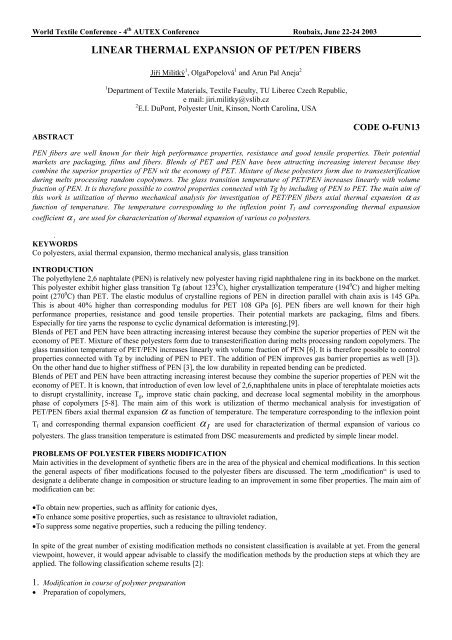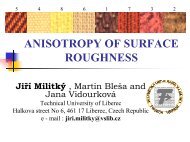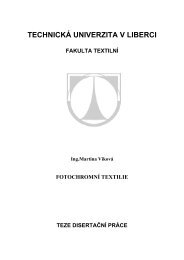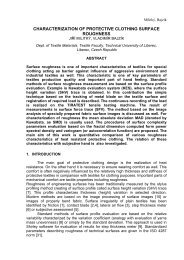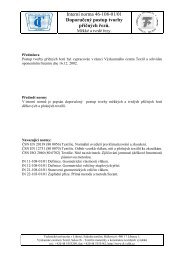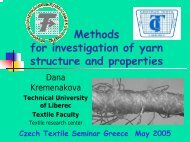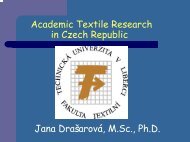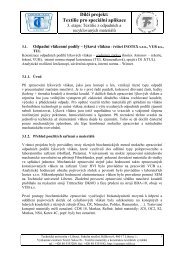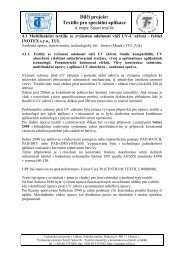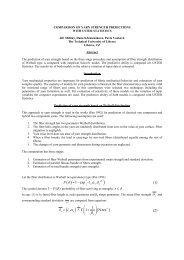linear thermal expansion of pet/pen fibers - Centrum Textil
linear thermal expansion of pet/pen fibers - Centrum Textil
linear thermal expansion of pet/pen fibers - Centrum Textil
You also want an ePaper? Increase the reach of your titles
YUMPU automatically turns print PDFs into web optimized ePapers that Google loves.
World <strong>Textil</strong>e Conference - 4 th AUTEX Conference Roubaix, June 22-24 2003<br />
LINEAR THERMAL EXPANSION OF PET/PEN FIBERS<br />
Jiří Militký 1 , OlgaPopelová 1 and Arun Pal Aneja 2<br />
1 Department <strong>of</strong> <strong>Textil</strong>e Materials, <strong>Textil</strong>e Faculty, TU Liberec Czech Republic,<br />
e mail: jiri.militky@vslib.cz<br />
2 E.I. DuPont, Polyester Unit, Kinson, North Carolina, USA<br />
ABSTRACT<br />
CODE O-FUN13<br />
PEN <strong>fibers</strong> are well known for their high performance properties, resistance and good tensile properties. Their potential<br />
markets are packaging, films and <strong>fibers</strong>. Blends <strong>of</strong> PET and PEN have been attracting increasing interest because they<br />
combine the superior properties <strong>of</strong> PEN wit the economy <strong>of</strong> PET. Mixture <strong>of</strong> these polyesters form due to transesterification<br />
during melts processing random copolymers. The glass transition temperature <strong>of</strong> PET/PEN increases <strong>linear</strong>ly with volume<br />
fraction <strong>of</strong> PEN. It is therefore possible to control properties connected with Tg by including <strong>of</strong> PEN to PET. The main aim <strong>of</strong><br />
this work is utilization <strong>of</strong> thermo mechanical analysis for investigation <strong>of</strong> PET/PEN <strong>fibers</strong> axial <strong>thermal</strong> <strong>expansion</strong> α as<br />
function <strong>of</strong> temperature. The temperature corresponding to the inflexion point T I and corresponding <strong>thermal</strong> <strong>expansion</strong><br />
coefficient α are used for characterization <strong>of</strong> <strong>thermal</strong> <strong>expansion</strong> <strong>of</strong> various co polyesters.<br />
I<br />
.<br />
KEYWORDS<br />
Co polyesters, axial <strong>thermal</strong> <strong>expansion</strong>, thermo mechanical analysis, glass transition<br />
INTRODUCTION<br />
The polyethylene 2,6 naphtalate (PEN) is relatively new polyester having rigid naphthalene ring in its backbone on the market.<br />
This polyester exhibit higher glass transition Tg (about 123 0 C), higher crystallization temperature (194 0 C) and higher melting<br />
point (270 0 C) than PET. The elastic modulus <strong>of</strong> crystalline regions <strong>of</strong> PEN in direction parallel with chain axis is 145 GPa.<br />
This is about 40% higher than corresponding modulus for PET 108 GPa [6]. PEN <strong>fibers</strong> are well known for their high<br />
performance properties, resistance and good tensile properties. Their potential markets are packaging, films and <strong>fibers</strong>.<br />
Especially for tire yarns the response to cyclic dynamical deformation is interesting.[9].<br />
Blends <strong>of</strong> PET and PEN have been attracting increasing interest because they combine the superior properties <strong>of</strong> PEN wit the<br />
economy <strong>of</strong> PET. Mixture <strong>of</strong> these polyesters form due to transesterification during melts processing random copolymers. The<br />
glass transition temperature <strong>of</strong> PET/PEN increases <strong>linear</strong>ly with volume fraction <strong>of</strong> PEN [6]. It is therefore possible to control<br />
properties connected with Tg by including <strong>of</strong> PEN to PET. The addition <strong>of</strong> PEN improves gas barrier properties as well [3]).<br />
On the other hand due to higher stiffness <strong>of</strong> PEN [3], the low durability in repeated bending can be predicted.<br />
Blends <strong>of</strong> PET and PEN have been attracting increasing interest because they combine the superior properties <strong>of</strong> PEN wit the<br />
economy <strong>of</strong> PET. It is known, that introduction <strong>of</strong> even low level <strong>of</strong> 2,6,naphthalene units in place <strong>of</strong> terephtalate moieties acts<br />
to disrupt crystallinity, increase T g , improve static chain packing, and decrease local segmental mobility in the amorphous<br />
phase <strong>of</strong> copolymers [5-8]. The main aim <strong>of</strong> this work is utilization <strong>of</strong> thermo mechanical analysis for investigation <strong>of</strong><br />
PET/PEN <strong>fibers</strong> axial <strong>thermal</strong> <strong>expansion</strong> α as function <strong>of</strong> temperature. The temperature corresponding to the inflexion point<br />
T I and corresponding <strong>thermal</strong> <strong>expansion</strong> coefficient α I are used for characterization <strong>of</strong> <strong>thermal</strong> <strong>expansion</strong> <strong>of</strong> various co<br />
polyesters. The glass transition temperature is estimated from DSC measurements and predicted by simple <strong>linear</strong> model.<br />
PROBLEMS OF POLYESTER FIBERS MODIFICATION<br />
Main activities in the development <strong>of</strong> synthetic <strong>fibers</strong> are in the area <strong>of</strong> the physical and chemical modifications. In this section<br />
the general aspects <strong>of</strong> fiber modifications focused to the polyester <strong>fibers</strong> are discussed. The term „modification“ is used to<br />
designate a deliberate change in composition or structure leading to an improvement in some fiber properties. The main aim <strong>of</strong><br />
modification can be:<br />
•To obtain new properties, such as affinity for cationic dyes,<br />
•To enhance some positive properties, such as resistance to ultraviolet radiation,<br />
•To suppress some negative properties, such a reducing the pilling tendency.<br />
In spite <strong>of</strong> the great number <strong>of</strong> existing modification methods no consistent classification is available at yet. From the general<br />
viewpoint, however, it would appear advisable to classify the modification methods by the production steps at which they are<br />
applied. The following classification scheme results [2]:<br />
1. Modification in course <strong>of</strong> polymer preparation<br />
• Preparation <strong>of</strong> copolymers,
World <strong>Textil</strong>e Conference - 4 th AUTEX Conference Roubaix, June 22-24 2003<br />
• Using additives,<br />
• Reducing the molecular mass.<br />
1. Modification in course <strong>of</strong> fiber preparation<br />
• Drawing and setting conditions readjusting,<br />
• Speed <strong>of</strong> spinning changing,<br />
• Texturing,<br />
• Cross section geometry changing,<br />
• Fineness changing,<br />
• Bi-component and multi-component <strong>fibers</strong> production.<br />
1. Modification applied to commercial <strong>fibers</strong><br />
• Grafting,<br />
• Plasma etching,<br />
• Controlled surface destruction.<br />
1. Combined modification<br />
(e.g. hollow microporous copolyester <strong>fibers</strong> containing additives)<br />
Details about these modifications are summarized in the book [2]. The description <strong>of</strong> modification effect on fiber properties is<br />
complicated by the fact that modification affects not only fiber structure and fiber properties but also conditions <strong>of</strong> fiber<br />
preparation. The main problems can be summarized to the following points:<br />
• It is difficult to measure structural parameters directly influencing given property (tie chain)<br />
• The properties are distinctly de<strong>pen</strong>dent on chemical composition <strong>of</strong> fibbers (chain flexibility)<br />
• Structural parameters are measured in static state whereas properties are usually determined in a dynamic state<br />
• Structure is changed during the measurement <strong>of</strong> some properties<br />
Influence <strong>of</strong> commoner on fiber properties can divided to the following categories<br />
A. Commoner has no effect<br />
B. Commoner has indirect effect<br />
C. Only the commoner amount matters (equilibrium melting point)<br />
D. It is the type <strong>of</strong> commoner that matters (Tg, dyeability)<br />
E. Commoner type and concentration have effect simultaneously<br />
Modification generally affect on the other technologically important characteristics as technology <strong>of</strong> fibre preparation,<br />
molecular mass <strong>of</strong> melt, degree <strong>of</strong> melt degradation and rate<br />
<strong>of</strong> crystallization. It is therefore difficult to separate effect <strong>of</strong> chemical modification from modification <strong>of</strong> technological<br />
parameters. Effect <strong>of</strong> combined physical and chemical modification on the basic structural characteristics and dyeability <strong>of</strong><br />
modified <strong>fibers</strong> is described in the [1]).<br />
PET/PEN FIBERS<br />
It is known, that introduction <strong>of</strong> even low level <strong>of</strong> 2,6,naphthalene units in place <strong>of</strong> terephtalate moieties acts to disrupt<br />
crystallinity, increase Tg, improve static chain packing, and decrease local segmental mobility in the amorphous phase <strong>of</strong><br />
copolymers. These results are supported by the geometrical structure <strong>of</strong> the two units (see fig.1)<br />
O<br />
C<br />
O<br />
C<br />
O<br />
C<br />
O<br />
C<br />
0.8 nm<br />
0.57 nm<br />
A<br />
Fig. 1 Dimensions <strong>of</strong> 2,6 naphthalene (A) and terephtalate (B) units<br />
B
World <strong>Textil</strong>e Conference - 4 th AUTEX Conference Roubaix, June 22-24 2003<br />
The molar volume <strong>of</strong> PEN V PEN = 182.4 cm 3 /mol is higher than molar volume <strong>of</strong> PET V PET = 144 cm 3 /mol. The amorphous<br />
density <strong>of</strong> PEN ρ aPEN = 1327 kg/m 3 is lower than amorphous density <strong>of</strong> PET ρ aPET = 1333 kg/m 3 . The crystalline density <strong>of</strong><br />
PEN ρ cPEN = 1407 kg/m 3 is lower than density <strong>of</strong> PET ρ cPET = 1440 kg/m 3 .<br />
The 2,6, naphthalene unit is substantially larger and does not fit into the unit cell <strong>of</strong> PET. The bulky kinked 2,6 naphtalene<br />
units in PEN are much less mobile than the terephtalate units. Amorphous phase free volume and local segmental mobility are<br />
reduced due to PEN presence. At the temperatures around 60 0 C or higher the motion <strong>of</strong> rigid naphthalene ring occur. One<br />
possible motion is hindered rotations <strong>of</strong> the naphthalene rings about the backbone. Another possible motion is interlayer<br />
slippage <strong>of</strong> the naphthalene rings. Both types <strong>of</strong> motion are schematically drawn on the fig. 2 [7].<br />
During the deformation <strong>of</strong> PEN, the naphthalene rings are rapidly aligned parallel to the surface <strong>of</strong> the <strong>fibers</strong> and also occurs at<br />
highly localized regions. The subsequent slippage can leads to necking behavior during deformation. The naphthalene portions<br />
exhibit higher creep compliance.<br />
Fig. 2 Possible mechanisms <strong>of</strong> 2,6 naphthalene rings motion<br />
Co polyesters <strong>of</strong> PET/PEN have a lot <strong>of</strong> interesting properties influenced by the presence <strong>of</strong> naphthalene rings. For some<br />
applications is interesting to know the degree <strong>of</strong> endurance in bending.<br />
PET/PEN FIBERS PREPARATION<br />
The co polyester samples having various content <strong>of</strong> PEN were prepared under comparable conditions. Basic characteristics <strong>of</strong><br />
these samples are given in the table 1.Melting behavior were investigated from DSC traces measured on the Perkin Elmer DSC<br />
6 apparatus. The melting peak has been characterized by melting temperature T m [ o C] (at peak maximum) and heat <strong>of</strong> fusion<br />
H f [J/g] (area under peak). Results are summarized in the table 1<br />
Table 1. Basic <strong>thermal</strong> properties <strong>of</strong> PET/PEN<br />
Sample PEN content [%] Tm [ o C] Tg [ o C] H f [J/g] α *10<br />
6 [deg<br />
−1 ] T I [ o C]<br />
A 0 254.77 77.62 51.35 0.44 57.88<br />
B 5 246.996 79.59 43.082 0.15 55.08<br />
C 10 236.235 82.52 49.16 0.63 71.74<br />
D 15 227.37 85.46 35.815 2.10 75.27<br />
E 20 214.016 87.4 36.479 5.44 77.48<br />
THERMAL ANALYSIS<br />
Thermal behavior were investigated from DSC traces measured on the Perkin Elmer DSC 6 apparatus. The melting peak has<br />
been characterized by melting temperature T m [ o C] (at peak maximum) and heat <strong>of</strong> fusion H f [J/g] (area under peak). Glass<br />
transition temperature Tg has been characterized by the point <strong>of</strong> inflection on the first endothermic bend on DSC trace. Results<br />
are summarized in the table 1. It is well known, that the Tg <strong>of</strong> random copolymers is lowered due to presence <strong>of</strong> modifying<br />
units. Because the PET/PEN forms random copolymer is glass transition temperature well described by the <strong>linear</strong> mixing rule<br />
(Gibbs-Di Marzio relation) [4]<br />
Tg( f ) = T * f + T * (1 − f ) (1)<br />
gPEN<br />
g PET<br />
I
World <strong>Textil</strong>e Conference - 4 th AUTEX Conference Roubaix, June 22-24 2003<br />
where and Tg(f) is in units [ 0 C]. From published values T gPET =81 o C T gPEN =123 o C it can be predicted ideal Tg(f). In reality is<br />
Tg de<strong>pen</strong>dent on a lot <strong>of</strong> molecular (molar mass and distribution) and structural factors and therefore these parameters should<br />
be computed for real polymers. The experimental de<strong>pen</strong>dence <strong>of</strong> Tg on f is shown on the fig. 5.<br />
Fig. 3. De<strong>pen</strong>dence <strong>of</strong> glass transition temperature Tg on PEN fraction f.<br />
The <strong>linear</strong>ity <strong>of</strong> Tg on f de<strong>pen</strong>dence is clear. The least squares regression model has the form.<br />
Tg = 77.402 + 50.86*f (2)<br />
From these values the Tg <strong>of</strong> both polyesters has been computed Tg PET =77.43, Tg PEN -=128.29.<br />
THERMO MECHANICAL ANALYSIS<br />
Temperature de<strong>pen</strong>dences <strong>of</strong> co polyesters dimensional changes h(T) were measured on the TMA CX apparatus. Typical h(T)<br />
curve is shown on the fig. 4. The axial <strong>thermal</strong> <strong>expansion</strong> were computed from well known relation<br />
1 ∆h(<br />
T )<br />
α =<br />
(3)<br />
l ∆T<br />
0<br />
where l 0 is initial sample thickness and ∆ h(T ) is first difference <strong>of</strong> dimensional changes. For computation <strong>of</strong> α (T ) and<br />
identification <strong>of</strong> the inflextion point the derivative analysis has beeen used. First <strong>of</strong> all the data were smoothed by the robust<br />
3R (three point repeating median) combined with Hamming windows [10]. Smoothed data were numerically derived by the<br />
three point central difference formula. Results for the sample No.E are shown on the fig. 5. The values T I and α<br />
I<br />
computed as<br />
coordinates <strong>of</strong> global maximum on the second derivative curve. The means from three repeating measurements are given in the<br />
last two columns <strong>of</strong> table 1.
World <strong>Textil</strong>e Conference - 4 th AUTEX Conference Roubaix, June 22-24 2003<br />
Fig 4. Typical h(T) curve for sample No. E<br />
Fig 5 First and second derivatives <strong>of</strong> h(T) for sample No. E<br />
The de<strong>pen</strong>dence <strong>of</strong><br />
α<br />
I<br />
on the volume fraction <strong>of</strong> PEN is given on the fig. 2.
World <strong>Textil</strong>e Conference - 4 th AUTEX Conference Roubaix, June 22-24 2003<br />
Fig 2. Influence <strong>of</strong> PEN content on the axial <strong>thermal</strong> <strong>expansion</strong> <strong>of</strong> copolyesters.<br />
The marked no <strong>linear</strong>ity <strong>of</strong> this de<strong>pen</strong>dence is probably valid in the restricted range <strong>of</strong> PEN concentration only.<br />
CONCLUSIONS<br />
A lot <strong>of</strong> PET/PEN <strong>fibers</strong> properties are connected with improved <strong>thermal</strong> and mechanical characteristics due to naphthalene<br />
rings presence. On the other hand the crystalline phase is lowered and mechanical relaxation caused by the motion <strong>of</strong><br />
naphthalene rings appeared. As results <strong>of</strong> these changes the increasing <strong>of</strong> PEN content leads to increasing <strong>of</strong> <strong>thermal</strong><br />
<strong>expansion</strong> coefficient α .<br />
I<br />
AKNOWLEDGEMENTS:<br />
This work was supported by the research project LN00B090 <strong>of</strong> Czech Ministry <strong>of</strong> Education<br />
REFERENCES<br />
[1] Militký, J.: Some theoretical problems <strong>of</strong> PET <strong>fibers</strong> modifications, Proc. Int. Conf. New Fiber, Ueda July 1999<br />
[2] Militký, J. et all. : Modified Polyester Fibers, Elsevier, Amsterdam 1991<br />
[3] McDowell C.C. et all.: Synthesis, physical characterization, and acetone sorption <strong>of</strong> random PET/PEN copolymers, J.<br />
Polym. Sci. B36, 2981 (1998)<br />
[4] Saleh Y.S., Jabarin A.: Glass transition and melting behavior <strong>of</strong> PET/PEN Blends, J. Appl. Polym. Sci. 81, 11 (2001)<br />
[5] Higashioji T., Bhusdan B.: Creep and shrinkage behavior <strong>of</strong> improved ultra thin polymeric film, J. Appl. Polym. Sci. 84,<br />
1477 (2002)<br />
[6] Nakamae K. et all. : Temperature de<strong>pen</strong>dence <strong>of</strong> the elastic modulus <strong>of</strong> the crystalline regions <strong>of</strong> PEN, Polymer 36, 1401,<br />
(1995)<br />
[7] Wu G., Cucullo J.A.: Structure and property studies <strong>of</strong> PET/PEN melt blended <strong>fibers</strong>, Polymer 40, 1011(1999)<br />
[8] Canadas J. C. et all.: Comparative study <strong>of</strong> amorphous and partially crystalline PEN, Polymer 41, 2899 (2000)<br />
[9] Sikkema D.J.: Manmade <strong>fibers</strong> one hundred years, J. Appl. Polym. Sci. 86, 484 (2002)<br />
[10] Meloun M., Militký J. and Forina M.: Chemometrics in Analytical Chemistry vol. II, Interactive Model Building and<br />
Testing on IBM PC, Ellis Horwood, Chichester 1994


